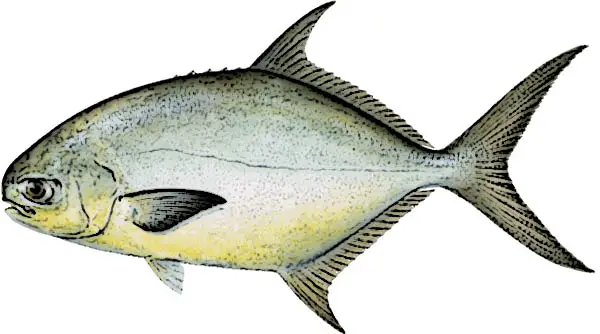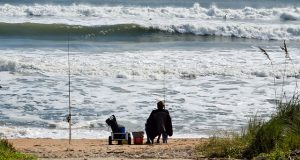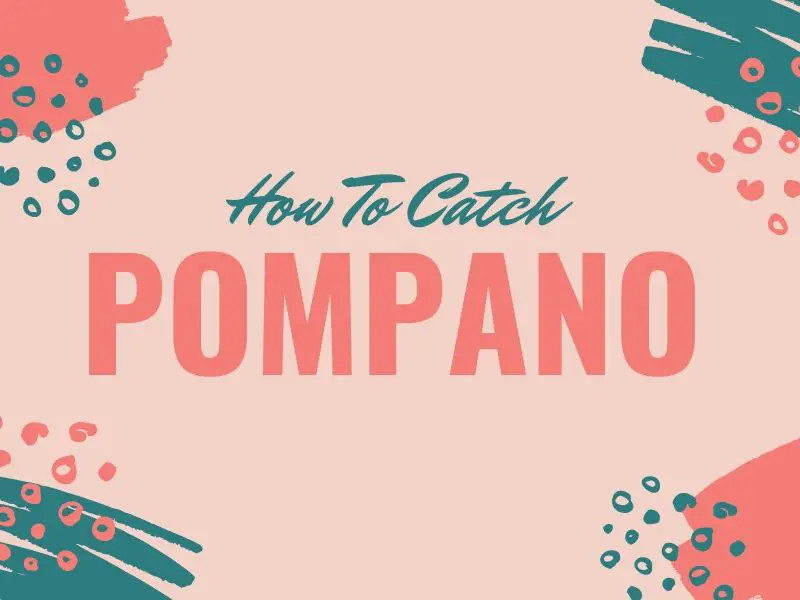Pompano are an extremely popular fish to catch for several reasons. They are known to be one of the best-tasting fish, they aren’t very difficult to catch, but they still put up a good fight, which makes it enjoyable to fish them.
If you’re fishing for pompano you need to read this guide. Here we will cover a little bit about pompano, where to fish for them, their seasonal patterns, the equipment you will need to catch them, and a few tips to help you catch more pompano.
How to Identify Pompano
Pompano are members of the Carangidae or jack family of fish. They often get confused with other members of their shared jack family such as permit. If you’re trying to identify pompano they have silvery and thin bodies with forked tail fins. They are also toothless and have elongated dorsal fins. Pompano can have dark or yellow-colored fins and may have black markings down the side of their bodies.

On average most pompano that are caught weigh less than 3 lbs and are less than 17 inches long. Though they can reach sizes upwards of 8 pounds. The world record pompano caught in Florida was a whopping 8.8lbs.
Where to Catch Pompano
Pompano fishing is popular in the western Atlantic Ocean from Massachusets down to Brazil. You can also regularly find them in the Gulf of Mexico ranging from Florida to Texas. Pompano fishing is more popular in Florida though, due to the high number of fish in this area.
If you’re trying to locate the pompano in the waters you are fishing, they are usually targeted by fishing in the surf. Pompano fishing is regularly done from shore, or from ocean-side piers. You can also target them by fishing inshore.
Look for areas with deeper sections than surrounding areas. Holes or cuts in the sandbar are good places to look. You can also fish rip currents where pompano might be lurking feeding on small fish that are being swept away.
What Do Pompano Eat?
Pompano regularly eat crabs, clams, shrimp, mussels and small fish. Using one of these as bait when fishing for pompano is always a good idea.
Pompano Seasonal Patterns
Fall
Pompano fishing is one of the most popular in the fall because pompano migrate south as the water gets colder. This can happen in October or December, depending on how cold it gets. When pompano start migrating south, the first place you want to fish is the beaches before the pompano settle into deeper estuaries. Pay attention to fishing reports to get clued in on when this activity begins.
If you’re fishing the surf in fall, wind and giant waves can push the pompano either close to shore or far offshore. It’s usually best to fish off the pier in case you need to cast past the breakers. If the beach doesn’t look good for fishing, you will need to cast further out to find the pompano.
Winter
Winter is known as the best pompano fishing season. This can be the ideal season to fish the surf for pompano. Cast out into smaller two to three-foot waves where pompano may be roaming. You can also look for them in troughs between sandbars. You can also find them deeper inshore in estuaries and lagoons. They may also be in grass flats hunting crabs when the tide is high.
Spring
Pompano in spring are easier to catch in northern parts of Florida than in southern parts. In the springtime, pompano are ready to head north for the summer. But you can still find pompano in their usual places: the surf, grass flats, and deep inshore channels. You can still find
Summer
In the summer fishing for pompano can be tough. They can be found in the gulf coast, but Florida isn’t a good spot to fish them, as most pompano move far north for the summer. If you’re fishing the gulf for summer pompano you can usually find them in deeper channels of estuaries. Look for bridges and piers over deep channels. They can be found during moving tides letting the current bring small crabs and shrimp to them.
Pompano Fishing Equipment
Rods and Reels
You can use a variety of kinds of fishing rods to catch pompano depending on the situation. Most commonly you will probably want to use either a spinning rod and reel, baitcasting rod, or fly rod.
Spinning rods and reels are versatile options that are great for beginners. A good 7-foot medium-action rod is a safe bet and can be used for most situations. If you’re fishing a rough surf, you may want a faster action rod.
Baitcasting rods and reels take a little more mastery to use but are ideal when you want to cast further distances. We recommend an 8-to-10 foot fast action casting rod. This should give you plenty of power to cast far enough to reach pompano.
Some anglers also like to use fly rods for fishing pompano. These are most common for inshore fishing but can also be used in the surf if the conditions aren’t too rough. If you opt for a fly rod you will want to use an 8 to 9 weight fast action rod. This will allow you to use the larger flies you need while giving you plenty of hook setting power for a tough pompano bite.
Lures and Baits
Bucktail Jigs
Many anglers swear by bucktail jigs for fishing pompano in the surf. Use something between ¼ and ½ ounce. You’ll probably get a few bites from other fish as well, but is that really a bad thing?
Pompano Jigs
These jigs come in various styles and colors. Some of them have colorful skirts, others are designed to imitate shrimp and other foods that pompano eat. These can work very well for pompano. You can even tip them with dead bait to make them even more effective.
Artificial Flies
Flies are another great choice. For pompano, you generally want a fast sinking fly. Many of the good ones are designed to imitate sand fleas. These tend to work better for inshore fishing.
Sand Fleas
Live bait is typically the best choice when it comes to pompano fishing. Sand fleas also known as mole crabs are known as one of the best baits you can use. When you find an area with a lot of sand fleas running around, there are sure to be hungry pompano feeding not far behind. You can typically scoop sand fleas with your hands to use as bait.
Shrimp
Live shrimp is always a good option. You can catch your own or buy them at a bait shop. Just try to use smaller shrimp if you can. If your shrimp are too large, you may have to use smaller pieces.
Fiddler Crabs
Pompano are also known to feed on fiddler crabs, which is why using these is bait works so well. You can usually catch your own, or you can buy them at a bait shop. Try to hook your fiddler crab between the back legs or through the back corner of the shell.
Squid
Fishing pompano with squid is ideal on days where the seas are rough. The pompano can pick up the smell through the rough waves. Try to cut the squid into pieces about an inch long.
Clams and Mussels
You may also go to your bait shop and pick up clams and mussels to use as bait. These give off an odor that can attract pompano. They also tend to stay on the hook in rough waves, which makes it great for fishing the surf.
Fishing Line
On calmer days you can use a lighter fishing line, however, when fishing a rough surf you will need a heavier line. If you’re using a spinning rod and reel, we recommend a 6 to 14 pound monofilament or fluorocarbon line.
For baitcasting conventional reels you probably want to use a heavier line in the 12 to 14-pound range. Again mono or fluorocarbon line will work.
Hooks
We recommend circle hooks for fishing pompano. Usually either a size #1, 1/0, or 2/0 circle hook for most situations. Just try to make sure your hook matches the size or your bait as best you can.

Pompano Fishing Tips
Use Gentle Hook Sets
For pompano you don’t need to use a powerful hookset. Often if you try to set your hook with too much force, you will end up jerking your bait right out of their mouth. Instead use a gentler flick of the wrist to set your hook. Many anglers also just begin to reel in their bait when they feel action.
Match the Hatch
Using live bait is often your best bait. You can even tip your jigs with small chunks of whatever the fish are feeding on in the waters you are fishing. Try to figure out what the fish are eating and use that as bait. If you find an area with a lot of fiddler crabs or sand fleas, you can be sure hungry pompano are close by.
Chum the Water
Chumming tends to work quite well for pompano. You can dump small chunks of baitfish, or scrape barnacles and mussels to chum the water and get the pompano riled up.
How Far in the Surf to Throw for Pompano
How far you need to throw when surfcasting will depend on the conditions of the water. Try to find the sandbar and break the length of the beach to the sandbar into three sections. Place your bait in each section and see if the pompano are biting. They usually travel in schools so once you find one, there will be plenty more. You could be casting less than 20 yards, 30 yards, or over 60 yards. It depends on where the sand bar is. Your best bet is to try multiple placements and see what gets the strikes.
Related Posts:
Snook Fishing Tips
Sheepshead Fishing Tips
How to Catch Bluefish
